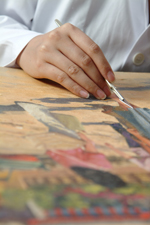Fading and Discolouration

Watercolours, photographs, dyed textiles, paper and coloured surfaces tend to discolour, fade and become structurally weak when exposed to light over a long period of time.
Damage from light exposure is cumulative and irreversible.
All visible light can cause fading and discoloration. However, ultra-violet rays reacting with sensitive components present in pigmented surfaces and dyed materials, cause the most damage.
At the other end of the spectrum, localised heating can cause desiccation, shrinkage and cracking from infrared rays and expansion or contraction due to fluctuating temperature.
You should:
- Avoid putting artefact near or under direct and intense lighting (especially direct sunlight).
- Reduce the damaging effects of the ultra-violet rays by adding filters to windows or light sources, or screening windows with curtains or blinds.
- Rotate light sensitive artefacts on display to minimise fading and discolouration.
- Keep storage areas dark and display areas lit with low wattage lamps.
- Use an ultra-violet filtering acrylic sheet in front of framed artworks.